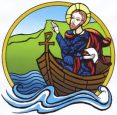ST COLUMBA
Feast Day 9 June

Our Patron was born c. 521 in County Donegal and baptised Colm or Colum – which in Gaelic means dove. Translated into Latin it is Columba. In later life he was commonly called Colmcille. St Bede, the Father of English history, considered his name was a combination of Columba et cella, referring to the many cells or religious houses he established. On both sides Columba was of royal lineage.
As soon as he was considered old enough Columba began his schooling at several monastic schools, many of his teachers becoming Saints themselves, including St Finian, St Keiran, and St Canice. He became steeped in Irish history and literature, and was considered a poet of no mean order. Having been ordained a priest, Columba spent the next fifteen years going about Ireland preaching and founding monasteries of which the chief were those of Derry, Durrow and Kells.
In 563 he left Ireland with twelve companions in a wicker boat covered with leather for Iona, an island off South-West Scotland which had been given to him for a monastery. Columba was then 42, and he remained there for the rest of his life, returning to Ireland for occasional trips. Different reasons have been given for Columba’s leaving Ireland – some say he was responsible for a battle in which 3,000 men were slain, and as penance he exiled himself from his own country. His early biographers, including his successor at Iona, were more generous in saying that it was his love of Christ and his missionary zeal which took him to Scotland.
Iona is situated opposite the border between the Picts of the north and Scots of the South. It formed an ideal centre for missions to both peoples. He converted Brude, the king of the Picts, and there at Inverness he founded two churches. While his missionary work was impressive, Columba’s influence has probably been exaggerated. It would be more true to say that he was the inspiration for the work carried on by his successors.
Columba retained some form of authority over the monasteries he had founded in Ireland, and these he visited from time to time. As mediator at different councils he was instrumental in defending the social position of bards, advocating the education of the laity, and even securing the exemption of women from all military service.
When not engaged on missionary or diplomatic expeditions, Columba’s headquarters continued to be at Iona, where he was visited by all kinds of people, some desiring spiritual or bodily help, some attracted by his reputation for sanctity, his miracles and his prophecies. His manner of life was most austere – which he imposed on his monks – but with the passage of time his character mellowed. it was written that “he had the face of an angel; he was of an excellent nature, polished in speech, holy in deed, great in counsel. He never let a single hour pass without engaging in prayer or reading or writing or some other occupation. He endured the hardships of fasting and vigils without intermission by day and night.”
Four years before his death, Columba’s strength began to fail. He continued his work of transcribing books. Some of his poems still exist, as does a copy of the book of the Psalms. He died in his abbey church in this day 597, just before the office of Matins was about to begin.
